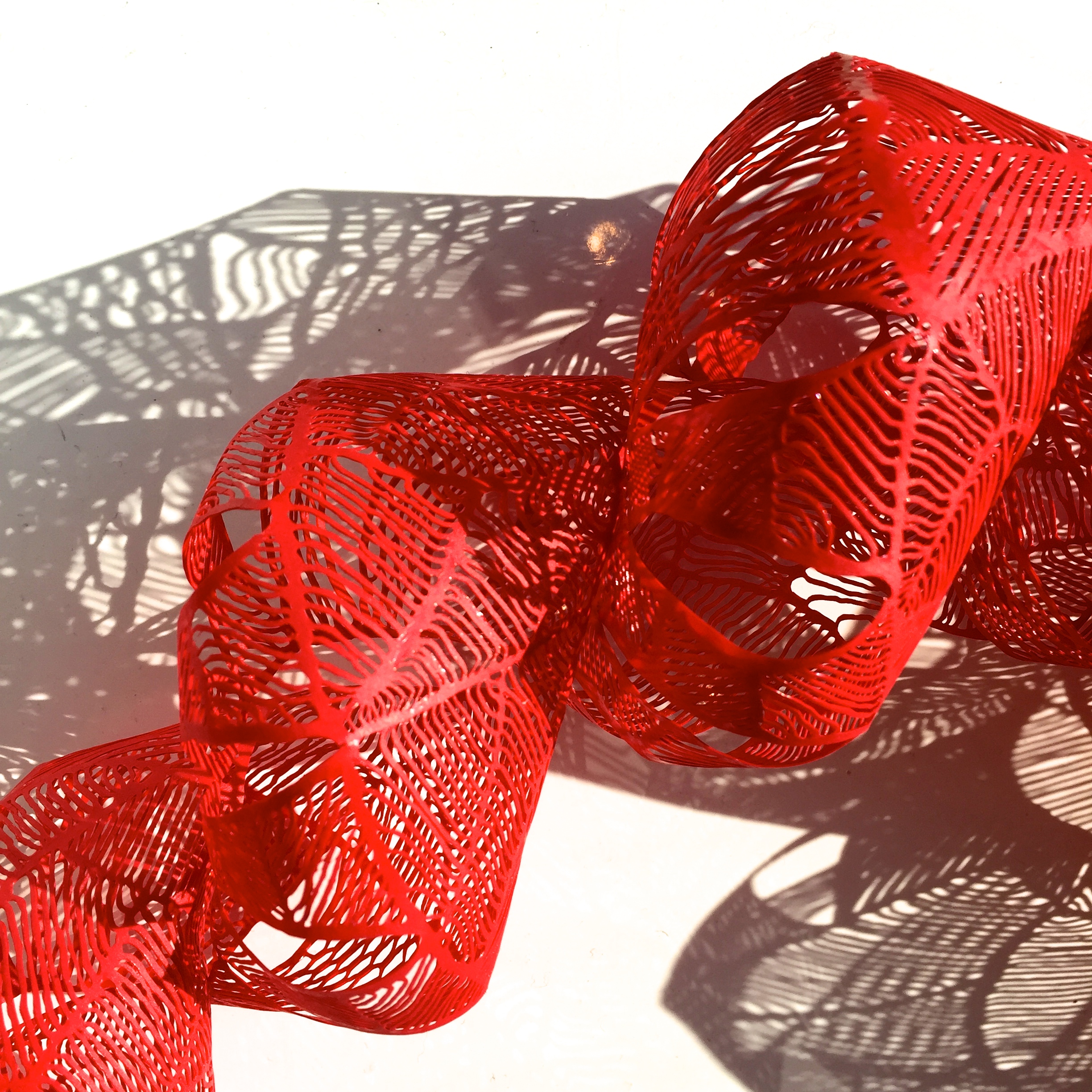
Alena Willroth, Detail einer muschelförmigen Kette, 2016. Mit freundlicher Genehmigung der Künstlerin. © Maja Peltzer
Alena Willroth verwandelt Polyethylenfolie in grazilen Schmuck und andere schattenspielreiche Objekte wie Lampenschirme und Kostüme. Inspririert von einem befreundeten Maler, der seine Bilder aus Kunststofffolien macht, beginnt sie 2013 mit dem Material zu experimentieren und entwickelt ein Verfahren, durch das ihr die Konstruktion von skulpturalen Formen möglich ist.
Als Namen für ihr Label wählte Alena Willroth das tschechische Wort für Wonne: „Slast“. Das altmodische, barocke Wort erinnert an die Gottesfreude, wie sie in Kantaten von Bach und Telemann besungen wird. Von einer weniger gottesfürchtigen und sehr lustvollen Wonne erzählt der Halsschmuck von Alena Willroth, der, wen wundert’s, auch Formen von aufwendig gestaltete Krägen aus Spätrenaissance und Barock wieder aufleben lässt.

Alena Willroth, 2016, Mühlsteinkragenartiger Halsschmuck, 2016, mit freundlicher Genehmigung der Künstlerin. © Maja Peltzer
Der große Luxus, der mit der Ausgestaltung der Krägen, insbesondere der Halskrause respektive Mühlsteinkragen zur Mitte des 16. Jahrhunderts betrieben wurde, hallt in Willroths Arbeiten nach. Seinerzeit erwartete der Bräutigam von den Händen seiner Braut ein kunstvoll gesticktes Hemd mit Kragen und sogar die Magistrate machten Vorschriften darüber, wie kostbar die Gabe zu sein habe. Die wonnevolle Ausgestaltung der Krägen war jedoch im Barock nicht immer gern gesehen, im gegenreformatorischen Spanien der 1620er Jahre wurde sie gar wegen der ihr angelasteten Verschwendungslust verboten, weiss Max von Boehn in seiner Kulturgeschichte der Mode zu berichten.
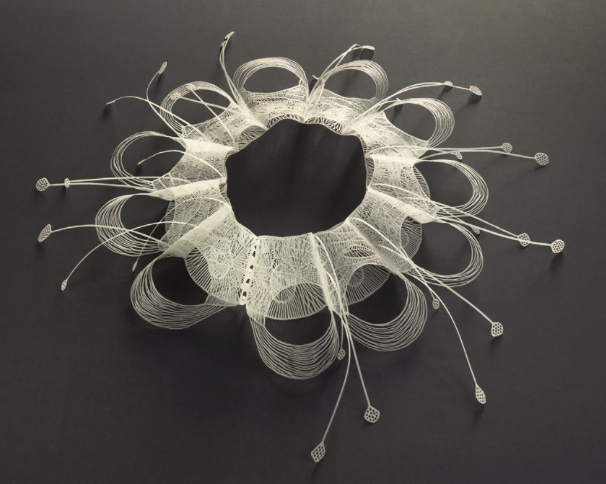
Alena Willroth, 2016, Halsschmuck, Mit freundlicher Genehmigung von © Hannes Willroth
Überirdische Schönheit
Der Konflikt zwischen Gotteslust und Gotteslästerung, der damals angesichts kunstvoller Schmuck- und Luxusgegeständen entbrannte, taucht in Willroths Arbeiten zwar nicht auf, dennoch spielt auch sie auf einer barocken Tastatur. Sie zelebriert prachtvolle Variationen von historischen Kragenformen, Muschelketten und Ohrringen. Dabei kultiviert sie Schönheits- und Gestaltungstechniken, indem sie Vergangenes und Gegenwärtiges zu einer neuen, hybriden Form verbindet. Ihre Arbeit zeichnet sich durch Präzision und Perfektion in der Ausführung aus, wobei der Eigenwillen des Materials im Detail eine seltsame, regelwidrige – eben barocke Form schafft. Derweil zeugt die erstaunliche Komposition von Organischem und Künstlichem in den Objekten von einer Suche nach etwas Noch-nie-da-gewesenem. Mutet die in der Wechselwirkung von Präzision und Zufall entstehende Schönheit für den Betrachter nahezu überirdisch, kosmisch an, sei sie, so Willroth, angesichts des glücklichen Gelingens ihres Vorhabens auch voller Demut.
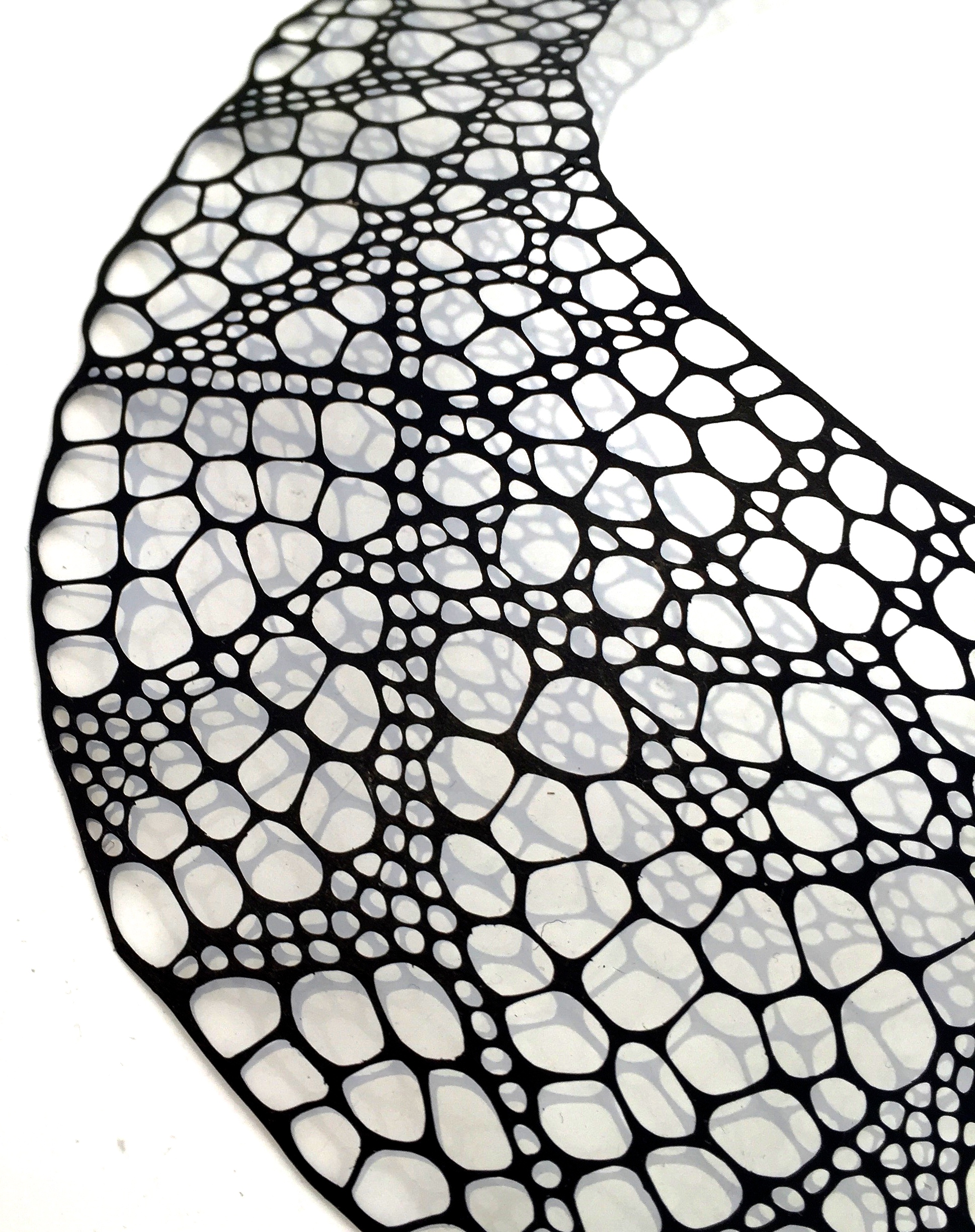
Alena Willroth, Detail, 2016, mit freundlicher Genehmigung der Künstlerin. © Maja Peltzer
Überirdische, kosmische, gar himmlische Schönheit ist ein wichtges Motiv für Alena Willroth. Dazu erzählte sie mir ihre Version von dem chinesischen Märchen Der Zauberteppich, in der eine Mutter von drei Söhnen einen so perfekten Teppich webt, dass die Götter ihn mitnehmen und im Himmel kopieren. Einer der drei Söhne macht sich auf und bringt den Teppich zurück. Die Mutter jedoch war aufgrund der ungemeinen Anstrengung beim Weben erblindet. Als sie aber den Teppich wieder bei sich hat, kehrt auch ihr Augenlicht zurück.
Die himmlische Kostbarkeit des Teppichs hat Alena als Kind tief beeindruckt und prägt sie bis heute nachhaltig. Und auch das Motiv von der Suche nach höchster Perfektion und von einem Verlust, der damit verbunden sein kann, ist ihr bekannt. Denn zeitgleich mit der Hingabe an die Schmuckherstellung verlor sie ohne schwerwiegende gesundheitliche Ursachen alle ihre Haare. Das Zusammenfallen dieser Begebenheiten kommt ihr selbst wie ein Schicksals-Spiel vor. Wahrscheinlich, so sagt sie, wird Beides für sie auf immer verbunden bleiben.
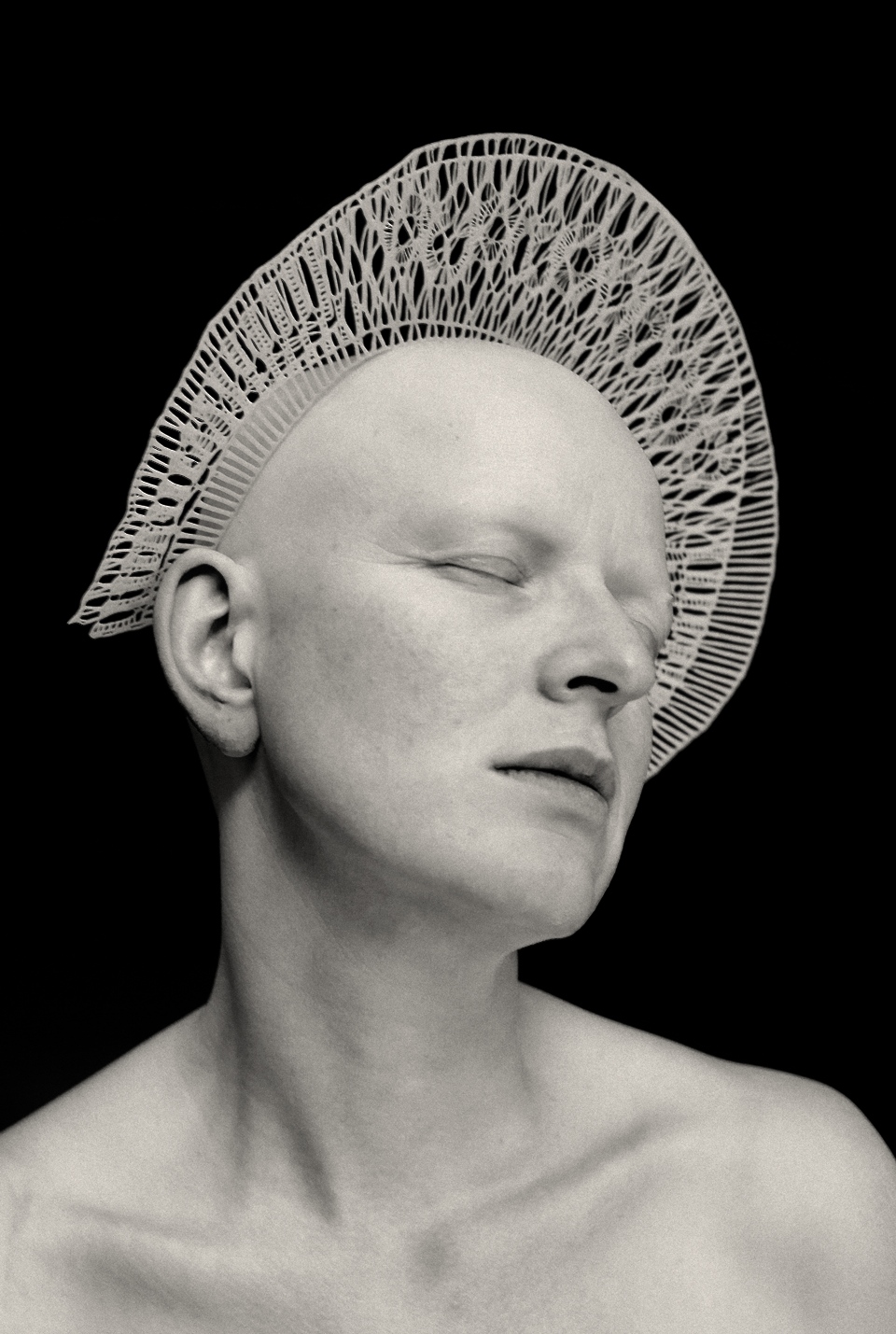
Alena Willroth mit Krone © Hannes Willroth
Leicht und Sperrig
Die spinnenwebenartigen Gebilde, die Alena Willroth herstellt, sind trotz ihres Volumens federleicht. Doch diese Leichtigkeit täuscht darüber hinweg, dass die Sperrigkeit des Materials für die Formgebung eine penible Planung fordert, und dass jeder Millimeter zuviel eine ungewollte Wirkung entfalten kann.
Die studierte Modedesignerin aus Prag konstruiert ihre Entwürfe so auch auf der Basis von Mode-Schnitttechnik und Geometriewissen. Sie fertigt vorab Papiermodelle, an denen sie ihre Formen erprobt und weiter entwickelt. Dann erst zeichnet sie die geometrischen Entwürfe auf geschichtete und leicht vorgepresste Folien und löst die Leerräume mit einem Skalpell aus. Unter Wärme und Druck werden anschließend die Schichten und in einem weiteren Arbeitsschritt die Schnittteile fest miteinander verbunden. Dabei prägt das Material dem bis hierhin komplett kalkulierten Entstehungsprozess des Schmuckstücks quasi seinen eigenen Willen ein und verändert es auf unvorhersehbare Weise. Die Schnittkanten verlieren ein wenig von ihrer Strenge, Unregelmäßigkeiten erhalten Einzug und es wird formstabil. Das Spiel von Materialbeherrschung und Materialwillen zeigt sich so auf ganz wundersame Weise.
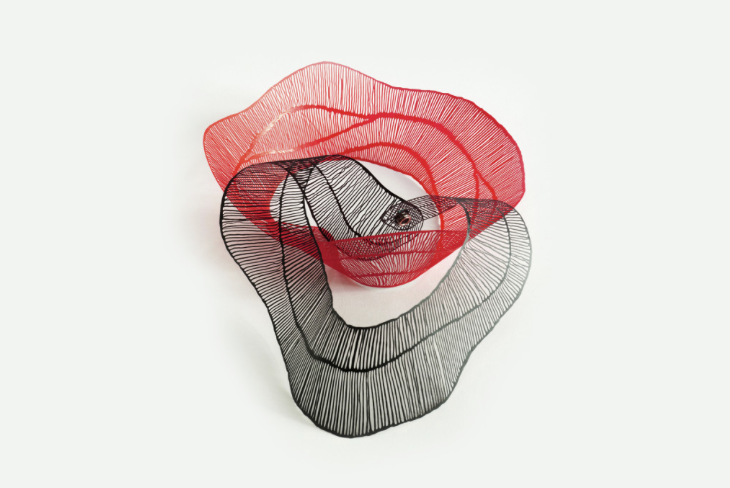
Mit freundlicher Genehmigung von ©Hannes Willroth
Auf meine Frage, warum sie sich für eine Folie und damit für eine geschlossene Oberfläche als Ausgangsmaterial für ihre Arbeiten entscheidet, antwortet Willroth, dass sie bei der Gestaltung ihrer organisch-kristallinen Formen auf der Fläche sehr frei und flexibel sei. Würde sie z.B. mit der Methode der Weißstickerei arbeiten, würden ihr das Gewebe und das Garn eine Formensprache diktieren, die sich für ihr Anliegen längst nicht so gut eignete. Die Suche nach einer neuen „Fasersprache“ macht somit die Wahl eines gewebefremden Materials notwendig. Mit diesem Abschied vom Gewebten emanzipiert sich Willroth auch von einem geschichtsträchtigen Medium. Die Spannung zwischen dem zeitgemäßen, sperrigen, neuen Material, und dessen Verwandlung in einzigartig faserigen Schmuck, der mal historische, mal kosmisch anmutende Formen annimmt, macht den besonderen Reiz von Alena Willroths Arbeiten aus.
So verwunderte es auch nicht, dass das Museum for Arts and Design in New York (MAD) Alena Willroth zu „LOOT: Mad about jewelry“ einer Verkaufsausstellung für junge und angesehene internationale Schmuck-Künstler einlud. Neben 40 ausgewählten, besonders innovativen Künstlern präsentierte und verkaufte sie dort vom 11-16. April 2016 ihre Schmuckobjekte und gewann den „LOOT Acquisition Prize“, mit dem eine ihre Arbeiten in die Sammlung des MAD aufgenommen wurde. Alena Willroth wins LOOT Acquistion Prize
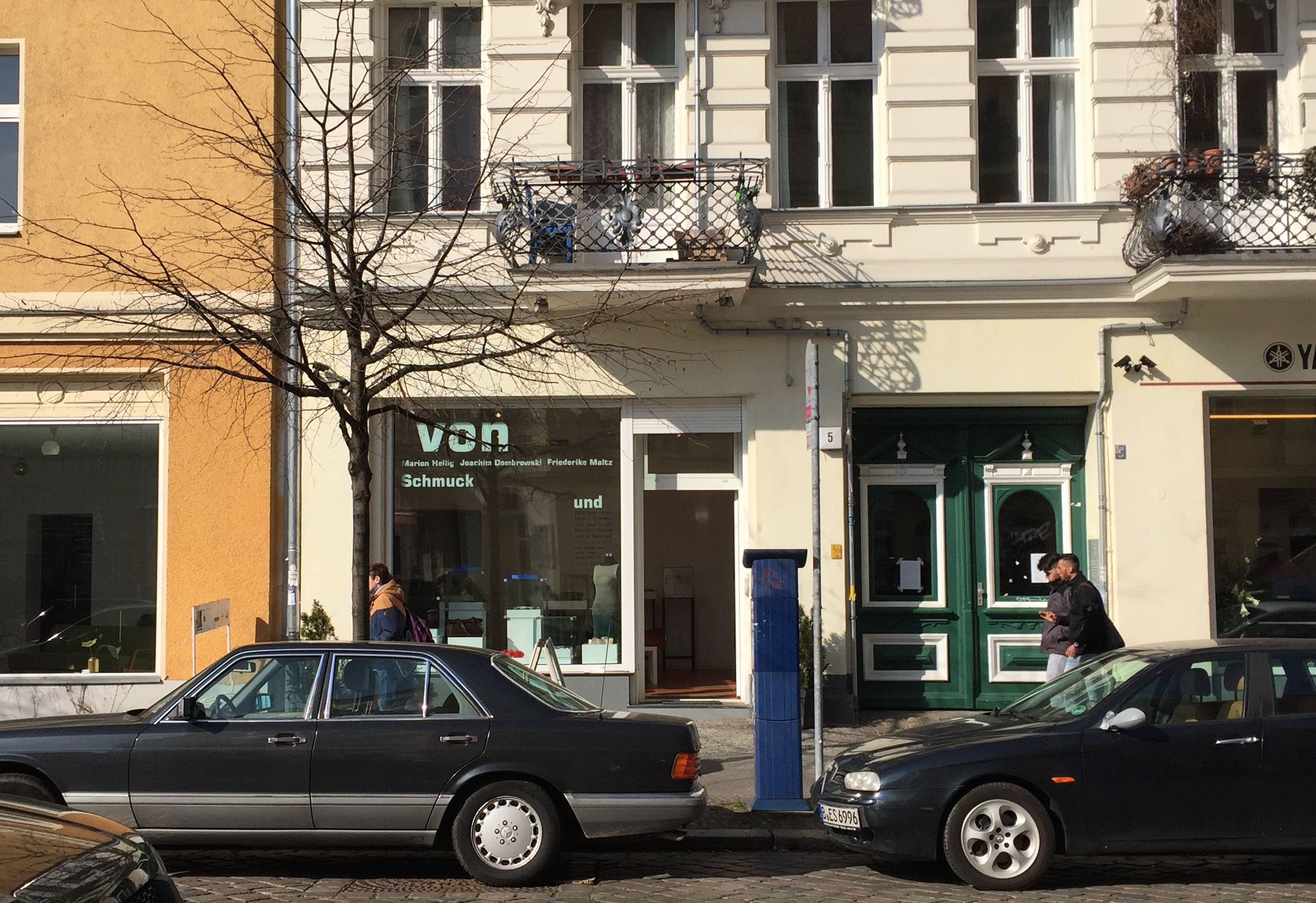
Alena Willroth ist eines von fünf neuen Mitglieder des AKBB (Berufsverband Angewandte Kunst Berlin-Brandenburg), die bis 26.3.2016 in der Galerie „von“ in der Lychenerstr. 5 vorgestellt wurden. Sie stellte darüber hinaus vom 22.4. – 8.5.2016 im Atelier Martina Dempf in der Remise aus.

Wenn Ihnen dieser Artikel gefallen hat und Sie auch in Zukunft mehr von mir lesen möchten, dann unterstützen Sie mich! Vielen Dank – Maja Peltzer, Herausgeberin von Der fremde Faden.
via PayPal mit 2,90 € / 5,00 € / 10,00 €
oder per Überweisung an:
Kontoinhaberin Maja Peltzer
IBAN DE57 5108 0060 0035 3073 04
BIC DRESDEFF510 (Dresdner Bank Wiesbaden)
Wenn Sie nicht wissen, wieviel Sie mir bezahlen möchten, dann klicken Sie hier!
THE COSMIC FIBERS OF ALENA WILLROTH

Alena Willroth converts polyethylene foil into delicate jewelry and shade-full objects like lampshades and costumes. Since 2013 she experiments with the material, being inspired by foil-paintings of a friend of hers. Meanwhile she continously develops procedures which facilitate the construction of sculptural forms made of foil.
Naming her label Slast, the Czech word for bliss, she chose an old-fashioned term with a baroque connotation, which is reminiscent of cantatas of Bach and Telemann, that praise the ecstasy of god. In a less pious but deeply joyfull bliss, the neck adornments of Alena Willroth enliven opulently shaped collars of the late renaissance and baroque.

The abundant luxury found in the arrangement of ruffs since the midst of the 16th century resonates in the work of Alena Willroth. At that time the bridegroom expected a skillfully stichted chemise with a crafted collar from the hands of his bride and even the magistrates canonized regulations on how precious the offering should be. The blissfully arranged collars weren’t tolerated throughout the entire baroque period, as Max von Boehn reports in his cultural history of fashion, and the counter-reformers in Spain accused them of indulgence and forbade them.

By courtesy of © Hannes Willroth
CELESTIAL BEAUTY
Even though the conflict between ecstasy and profanity of god, that flared up as a reaction to precious jewelry and luxury objects, does not appear in Alena Willroths work, she nevertheless is playing on baroque keys. She celebrates magnificent variations of historical collars, shell-necklaces and earrings. With it she cultivates techniques of beauty and design by combining the bygone and the contemporary in a new hybrid form.
 Her work is characterized by precision and perfect execution, while the self-willed material produces strange and aberrant, downright baroque forms. Meanwhile the astounding composition of the organic and the artificial testifies the search for something, that has never been there before. The beauty that emerges by the superposition of precision and coincidence is almost celestial and cosmic and Alena Willroth says, that she is full of humility as she felicitously succeeds in her work.
Her work is characterized by precision and perfect execution, while the self-willed material produces strange and aberrant, downright baroque forms. Meanwhile the astounding composition of the organic and the artificial testifies the search for something, that has never been there before. The beauty that emerges by the superposition of precision and coincidence is almost celestial and cosmic and Alena Willroth says, that she is full of humility as she felicitously succeeds in her work.
Celestial, cosmic and devine beauty is an important motif for Alena Willroth. To that she told me her version of the Chinese fairy-tail The Magic Tapestry, in which the mother of three sons wove such a perfect tapestry, that the gods took it away and copied it in heaven. One of the sons brought the tapestry back. The mother however went blind because of the strain of weaving. As she had the tapestry back in her home, her eyesight came back too.
The celestial preciousness of the tapestry impressed Alena deeply in her childhood and it marks her until today. Also the motif of searching for high perfection, that is connected to a loss, is familiar to her. At the same time with her dedication to manufacturing jewelry and without any serious health cause, she lost all her hair. This coincident appears to be a game of destiny, as Alena says, and she adds, that probably both sides of it will stay bound together for ever.

Alena Willroth with Crown © Hannes Willroth
LIGHT AND INTRACTABLE
The fabrics that Alena shapes are similar to cobwebs and despite their volume as light as a feather. Although this lightness belies the stubborness of the material, it is worth to emphasize its intractability, because it needs meticulous planning to get it into shape and each inaccurate millimeter could produce an unwanted effect.
The academically trained fashion designer from Prague develops her schemes on the base of pattern drawing and geometry. She first makes paper models by which she tests and develops the shapes. After that she traces the schemes onto piled and slightly pressed foils, cutting out the voidages with a scalpel. The layers and, in a second step, the sections are then joined together under heat and pressure. The completely calculated process is hereby exposed to the peculiarity of the material, which imposes its will into the piece of jewelry, changing it in unforeseeable ways. The cutting edges loose a little of their rigor and get irregular and the shape gets stable but not rigid. By this the play of material-control and material-willpower shows up in a wondrous way.

By courtesy of © Hannes Willroth
To my question on why she decided to use a foil and with it a closed surface as her starting material, Alena replies, that this kind of surface allows a very free and flexible performance of her organic-crystalline designs. If she would craft in whitework embroidery e.g., the webbing and the yarn would dictate a language of forms that is not appropriate for her purpose. The search for a new fiber-language made this choice external to webbing necessary. With this departing from the woven fabric, Alena Willroth also says goodbye to a medium steeped in history. The tension between the contemporary, intractable new material and its transformation into a unique fiber-jewelry, that adopts partly historical, partly cosmic design, comprises the particular charm of Alena Willroths work.
Exhibitions: LOOT: Museum of Arts & Design & Atelier Martina Dempf in der Remise
Alena Willroth has been awarded the inaugural LOOT Acquisition Prize on the occasion of the sixteenth edition of LOOT: MAD About Jewelry, the Museum’s annual exhibition and sale of designs by international emerging and acclaimed jewelry artists. Alena Willroth wins LOOT Acquistion Prize
Maja Peltzer is an independent publicist. Focusing on postcolonial and hybrid aesthetics, she writes for magazines and her blog called The Foreign Thread.
